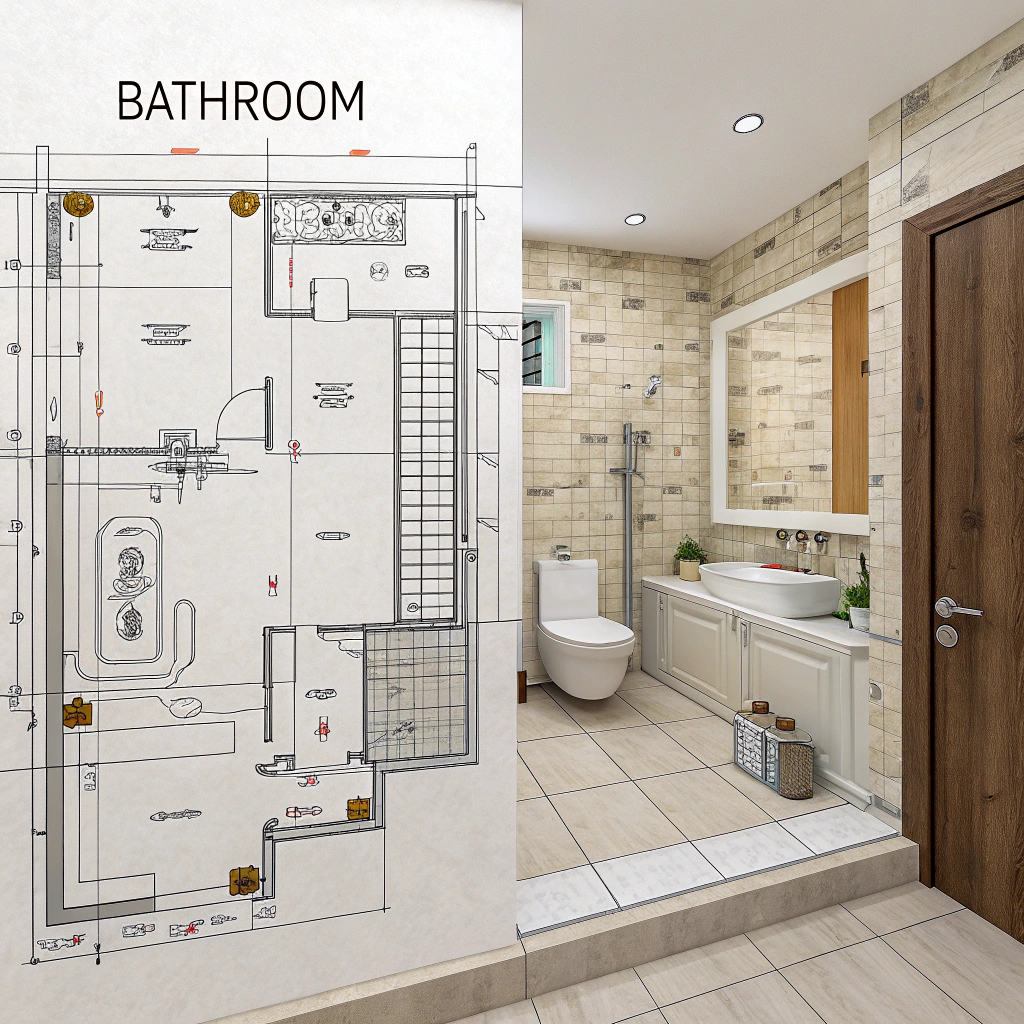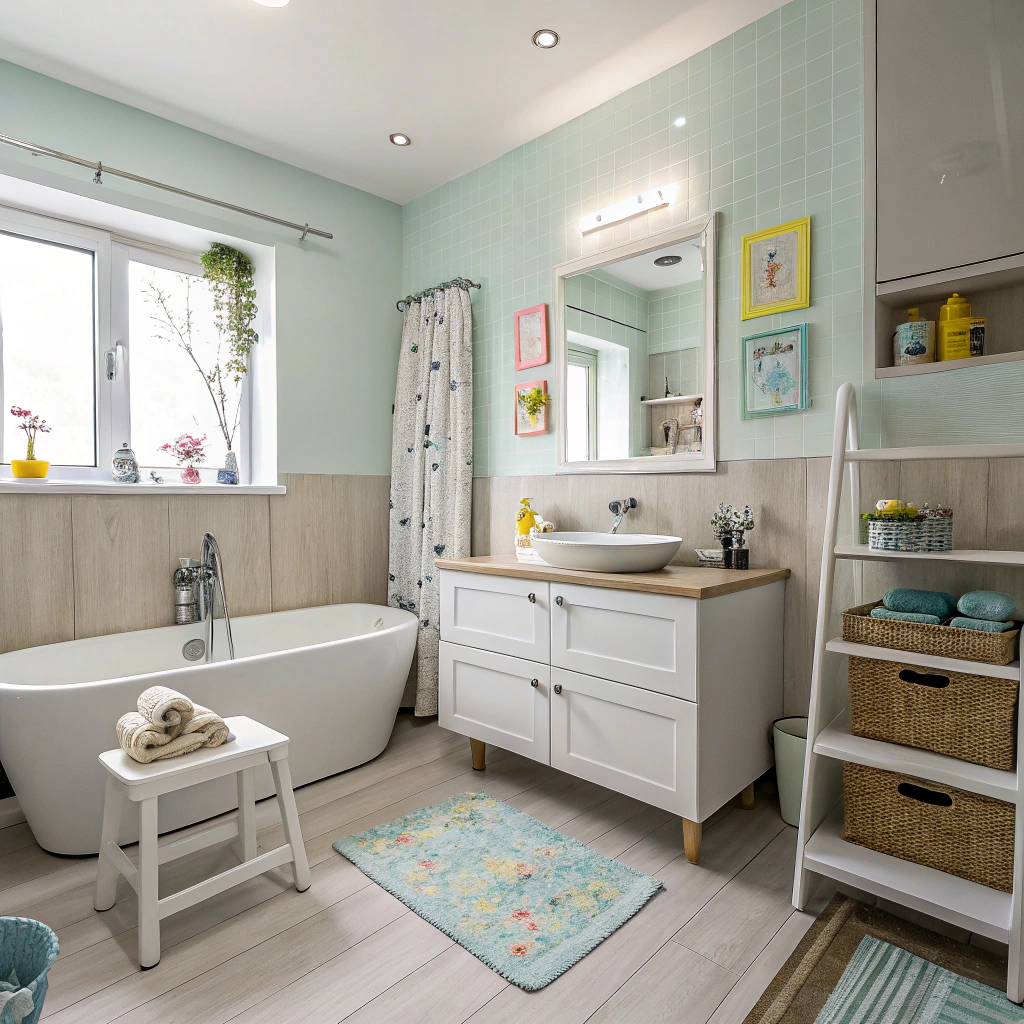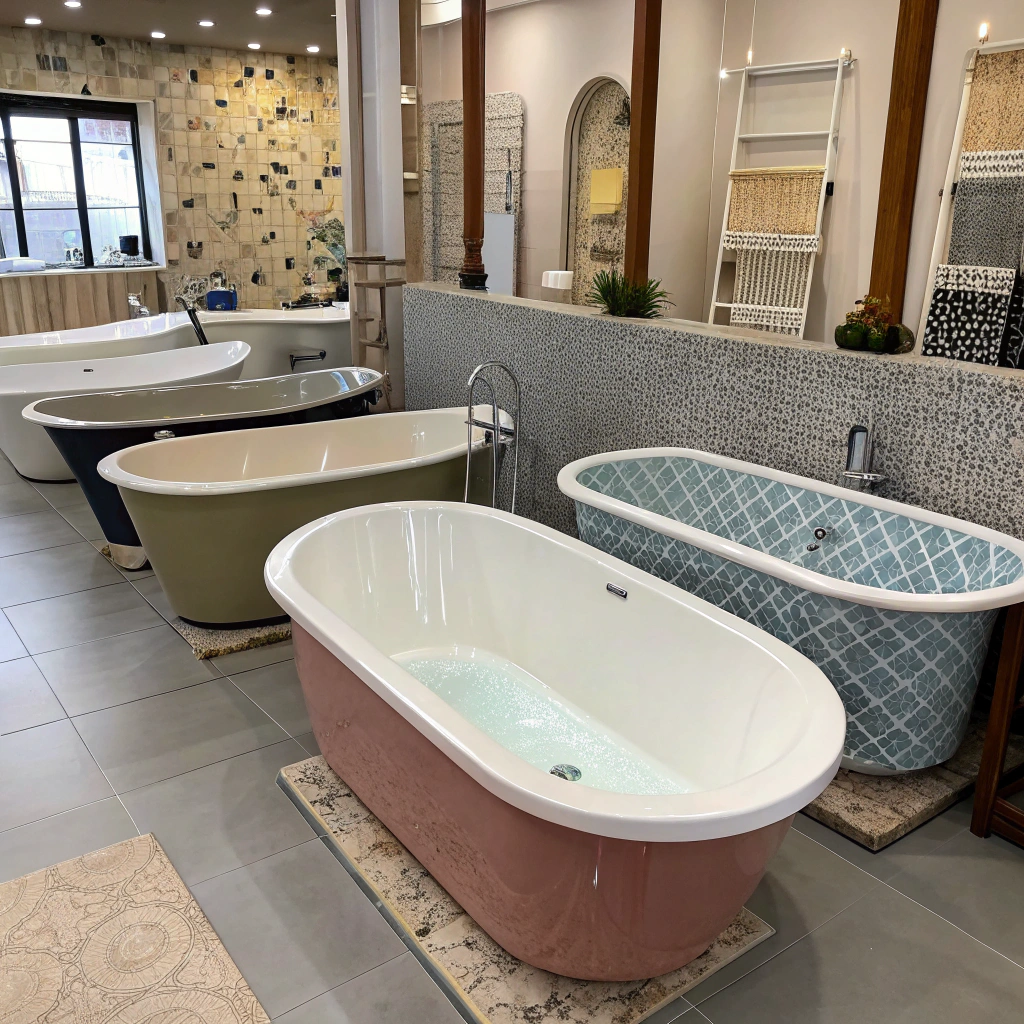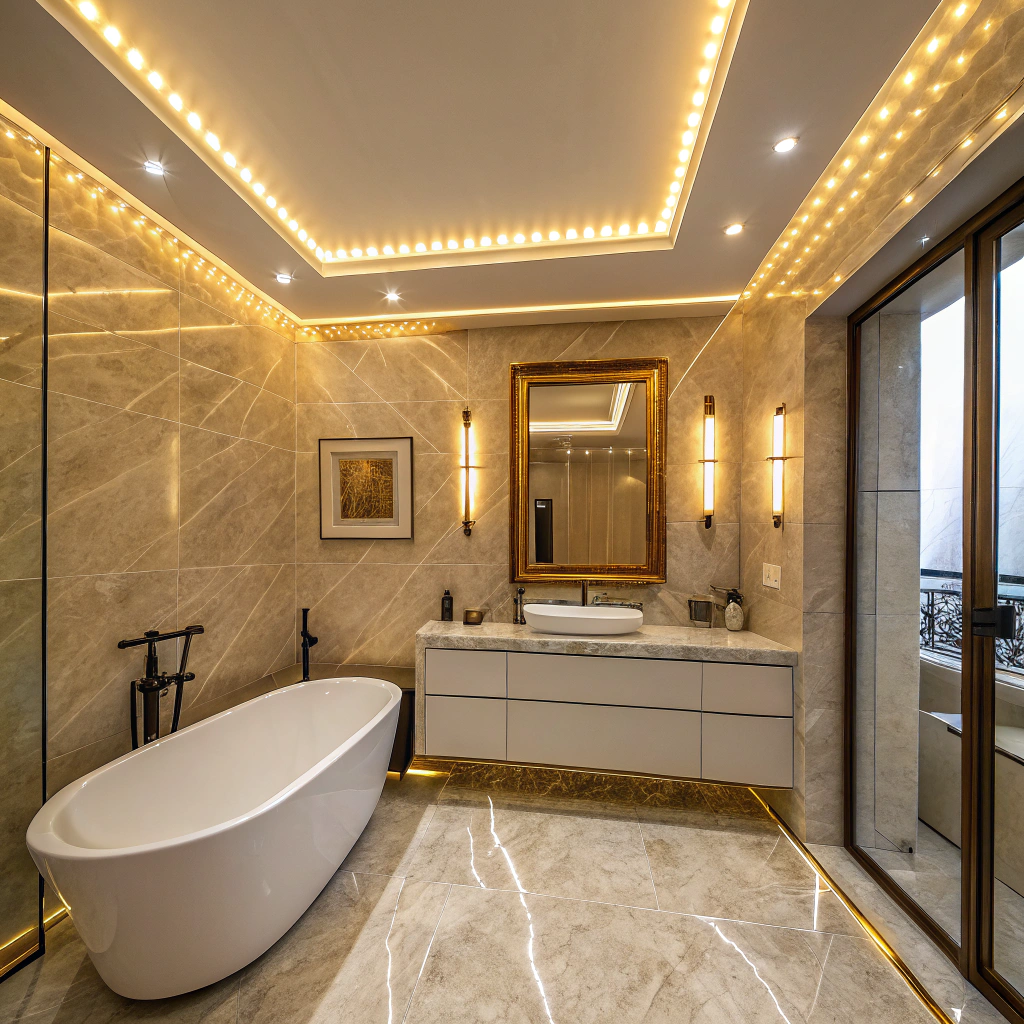Designing a bathroom is perhaps one of the most challenging yet rewarding interior design projects you can undertake in your home. Unlike other rooms where furniture can be easily rearranged or décor simply updated, bathrooms require careful planning, technical knowledge, and a clear vision from the start.
The typical bathroom presents unique challenges – it’s often one of the smallest rooms in the house yet needs to accommodate numerous fixtures and functions. Every inch matters when you’re trying to fit a toilet, sink, shower, bath, and storage into a compact space while still creating something beautiful and practical.
What makes bathroom design particularly demanding is the coordination required between various elements. You’ll likely be managing plumbers, electricians, tile installers, and other contractors, all while making decisions about fixtures, finishes, and layout. Without the guidance of a dedicated bathroom designer (which kitchens often benefit from), the process can feel overwhelming.

However, a well-designed bathroom offers tremendous benefits. It can become a personal sanctuary for relaxation, add significant value to your home, and make your daily routines more efficient and enjoyable. Whether you’re planning a family bathroom that needs to withstand the chaos of morning routines, a luxurious master en-suite for unwinding, or a compact powder room for guests, the principles of good design remain the same.
Where to start with Bathroom Interior Design
Before diving into fixtures and finishes, the first step in creating your dream bathroom is a thoughtful assessment of your needs and space. This initial planning phase will set the foundation for all your design decisions moving forward.
Analyzing Your Current Bathroom Usage
Start by evaluating how you currently use your bathroom. What works well? What frustrates you? Do you find yourself constantly searching for storage space? Is there enough counter area around the sink? Does the shower feel cramped? Take note of traffic patterns, pain points, and features you appreciate.
Consider keeping a small notebook in your bathroom for a week and jot down observations as they occur to you. These real-time insights can reveal needs you might otherwise overlook when planning from memory.
Creating a Wish List Based on Users’ Needs
Next, develop a comprehensive wish list that accounts for everyone who will use the space. A family bathroom serves different purposes than a private en-suite, and each user may have unique requirements:
- Do you need a bathtub for young children?
- Would a walk-in shower better serve aging family members?
- Is a double vanity essential for couples sharing the space?
- Do you need specialized storage for medical equipment or beauty products?
Prioritize these items by categorizing them as “must-haves,” “nice-to-haves,” and “dream features.” This hierarchy will help guide your decisions when budget or space constraints require compromises.
Considering Future Needs and Adaptability
A well-designed bathroom should serve you not just today but for years to come. Consider how your needs might evolve:
- If you’re planning to age in place, features like grab bars, curbless showers, and comfort-height toilets might be worth incorporating now.
- For growing families, a bathroom that can transition from kid-friendly to teen-appropriate will save remodeling headaches later.
- If you might sell your home in the near future, consider design choices with broader appeal.
Building in adaptability from the start can extend the functional lifespan of your bathroom and potentially increase your home’s value.
Determining the Primary Function
Every bathroom has a primary purpose that should guide its design:
- Family bathrooms need to be hardwearing, splash-proof, and equipped with ample storage. Durability should be a top consideration for materials and fixtures.
- Master en-suites can afford more luxury and personalization since they’re typically used by fewer people. This is where you might splurge on high-end finishes or spa-like features.
- Guest bathrooms should be welcoming and intuitive to use, with accessible storage for essentials visitors might need.
- Powder rooms can make a bold design statement since they’re smaller spaces used primarily by guests.
Understanding your bathroom’s primary function will help you make appropriate choices about everything from layout to lighting to materials. This clarity of purpose is the foundation upon which all your other design decisions will build.
Planning Your Bathroom Layout
The layout is the backbone of your bathroom design, determining not just how the space looks but how it functions on a daily basis. A well-planned layout maximizes every inch while creating a comfortable flow that makes the room a pleasure to use.
Key Factors That Influence Layout Decisions
Several critical factors will shape your layout possibilities:
- Room dimensions and shape: The physical boundaries of your space will dictate what’s possible.
- Window and door positions: These fixed elements affect where fixtures can be placed.
- Plumbing locations: Existing water supply and drainage points may limit where fixtures can go without significant expense.
- User needs: The specific requirements of those using the bathroom will influence priorities.
- Budget constraints: Some layout changes require more extensive plumbing work, affecting costs.
Before making any decisions, measure your space carefully and create a scaled floor plan. This will be your canvas for experimenting with different arrangements.
Creating an Impactful Entrance View
First impressions matter, even in bathroom design. Consider what will be visible when someone first opens the door:
- Aim to showcase attractive elements like a beautiful vanity or freestanding bath.
- Position the toilet so it’s not the first thing seen when entering the room.
- If possible, create a sight line to a window or decorative feature that draws the eye.
This thoughtful positioning creates a more welcoming and aesthetically pleasing experience from the moment someone enters the space.

Choosing a Focal Point for Your Design
Every well-designed bathroom benefits from having a clear focal point that anchors the space:
- A freestanding bathtub can serve as a stunning centerpiece.
- A dramatic vanity with a statement mirror can become the room’s highlight.
- A beautifully tiled shower area can draw attention and set the tone for the entire room.
Once you’ve identified your focal point, arrange other elements to complement rather than compete with it, creating a harmonious hierarchy within the space.

Working with Symmetry When Possible
Symmetrical layouts create a sense of balance and order that can be particularly pleasing in bathroom design:
- Consider twin sinks with matching mirrors if space allows.
- Align fixtures with architectural features like windows or alcoves.
- Use symmetrical lighting fixtures to frame key elements.
Even in asymmetrical spaces, you can create visual balance through thoughtful placement of fixtures and accessories.
Ensuring Adequate Space Around Fixtures
Functionality depends on having enough clearance around each bathroom element:
- Allow at least 30 inches of space in front of fixtures for comfortable use.
- Ensure shower doors have adequate swing space without hitting other fixtures.
- Consider the space needed when cabinet doors and drawers are fully open.
- In tight spaces, consider space-saving options like sliding doors, corner sinks, or over-bath showers.
These clearances aren’t just about comfort—they’re essential for safety and accessibility. If you are looking for inspiration for
Designing Different Types of Bathrooms
Family Bathroom Design
The family bathroom serves multiple users with varying needs, making versatility and durability paramount. This hardworking space needs to accommodate everything from bath time for toddlers to teenagers’ grooming routines.
For materials, opt for porcelain tiles with slip-resistant finishes on floors. These withstand constant moisture, heavy foot traffic, and are virtually maintenance-free. Solid surface countertops resist staining from cosmetics and toiletries, while quality fixtures in durable finishes like brushed nickel or chrome will stand up to daily use.

Storage is essential in family bathrooms. Consider a mix of open and closed storage—towel hooks at varying heights for different family members, vanities with drawers for organizing personal items, and perhaps a tall cabinet for bulkier supplies. Medicine cabinets with mirrors serve dual purposes while saving space.
Master En-Suite Design
Your master en-suite is a personal retreat where luxury and personal preference can take precedence over universal practicality. This is where you can indulge in high-end materials and create a spa-like atmosphere.

Consider natural stone, marble, or high-quality composite materials for surfaces. These may require more maintenance than family bathroom materials but offer unmatched elegance. Warming elements like heated floors and towel rails add comfort, especially in cooler climates.
If space permits, separate “his and hers” vanity areas reduce morning congestion and allow for personalization. A freestanding soaking tub creates a luxurious focal point, while a generous walk-in shower with multiple showerheads or body sprays offers everyday indulgence.
Lighting deserves special attention in a master bath. Layer ambient, task, and accent lighting on separate dimmer controls to create different moods—bright illumination for morning routines, softer lighting for relaxing evening baths.
For the ultimate luxury, consider integrating technology like built-in speakers, smart mirrors with integrated lighting, or programmable shower systems that remember your preferred temperature and flow settings.
Shower Rooms and Guest Bathrooms
Smaller bathrooms and dedicated shower rooms require thoughtful space optimization without sacrificing style or functionality.
In shower rooms, prioritize safety with thermostatic valves that prevent scalding and non-slip flooring. For guest bathrooms, intuitive fixtures that don’t require explanation make visitors feel comfortable. Wall-mounted toilets and vanities create an illusion of more floor space while facilitating easier cleaning.
Consider space-saving fixtures like corner sinks, sliding shower doors instead of swinging ones, and compact toilets designed for smaller spaces. Pocket doors can save valuable floor space compared to traditional swinging doors. Be sure to check out our board about Small bathroom designs to get more idea’s!
Selecting Key Bathroom Elements
Choosing the Perfect Bath
The bathtub often serves as the centerpiece of a bathroom, with options ranging from basic built-ins to statement freestanding pieces.

Material choice significantly impacts both aesthetics and function. Cast iron tubs offer exceptional heat retention but are extremely heavy and require floor reinforcement. Composite stone provides a similar look with less weight and easier maintenance. Acrylic offers affordability and lightweight installation but may lack the substantial feel of heavier materials.
Consider your bathing preferences when selecting a tub style. Deep soakers are ideal for immersive relaxation, while wider, shallower tubs might be more comfortable for bathing children. Whirlpool or air jet systems add therapeutic benefits but require additional maintenance and access points for mechanical components.
For smaller spaces, consider a Japanese-style soaking tub that’s deeper but with a smaller footprint, or a shower-bath combination with a curved end for more comfortable bathing.
Selecting Quality Brassware
Faucets, showerheads, and other brassware are the jewelry of your bathroom—and the components you’ll interact with most frequently. Quality here is a worthwhile investment.
Choose solid brass construction with high-quality finishes for longevity. Budget fixtures often use plastic components internally that deteriorate faster. Consider the water conditions in your area; hard water areas may benefit from easy-clean finishes that resist limescale buildup.

Match your brassware to your home’s water pressure system. Low-pressure systems require specifically designed fixtures, while high-pressure systems offer more options but may need pressure-reducing valves to prevent splashing and waste.
For a cohesive look, select brassware from the same collection or with complementary styling. Mixing modern minimalist faucets with traditional cross-handle shower controls can create visual discord unless intentionally done as part of an eclectic design scheme.
Flooring Options
Bathroom flooring must balance beauty with practicality, as it faces constant moisture exposure and temperature fluctuations.

Porcelain tile remains the gold standard for bathroom flooring due to its impermeability, durability, and vast design options. Large-format tiles reduce grout lines (and cleaning), while textured finishes provide slip resistance. Natural stone offers timeless beauty but requires regular sealing and more maintenance.
For a warmer feel underfoot, consider luxury vinyl tile or engineered vinyl planks, which provide wood-look options with waterproof properties. Engineered wood specifically designed for bathrooms can work with proper installation and maintenance, though it’s not recommended for family bathrooms with high moisture levels.
Whatever material you choose, consider installing underfloor heating for added comfort, particularly in colder climates. This not only provides luxurious warmth but helps floors dry faster, reducing moisture issues.
Storage Solutions
Effective storage transforms a bathroom from chaotic to calming, keeping necessities accessible while minimizing visual clutter.
Built-in storage maximizes space efficiency by utilizing otherwise wasted areas. Consider recessed medicine cabinets, niches in shower walls, and vanities with organizational drawer inserts. For period properties, bespoke joinery can create storage that complements architectural features.
In smaller bathrooms, think vertically with tall, narrow cabinets or open shelving above toilets. Ladder shelves can provide flexible storage without requiring wall mounting, while baskets and decorative containers on open shelves combine function with style.
Don’t overlook the inside of cabinet doors for additional storage potential—magnetic strips for metal items, small hooks for hanging items, or narrow shelves for smaller products can dramatically increase capacity without expanding footprint.
Lighting Your Bathroom
Lighting transforms a bathroom from purely functional to atmospheric, and should be planned early in the design process to ensure proper wiring and installation.

Create layers of light for flexibility: ambient lighting provides overall illumination, task lighting serves specific functions like makeup application or shaving, and accent lighting highlights architectural features or creates mood. Each layer should be independently controlled, ideally with dimmer switches.
For vanity areas, avoid overhead-only lighting that casts shadows on the face. Instead, position sconces or vertical fixtures on either side of mirrors for even facial illumination. In shower areas, recessed waterproof downlights provide safety and functionality.
Consider lighting temperature carefully—cooler lights (4000-5000K) provide truer color rendering for makeup application, while warmer lights (2700-3000K) create a more relaxing ambiance for evening baths. Some modern fixtures offer adjustable color temperatures to serve both purposes.
Smart lighting systems can transform your bathroom experience with programmable scenes—bright morning settings that gradually illuminate to wake you gently, or relaxing evening modes with dimmed lights for unwinding in the bath.
Final Considerations
Updating Architectural Elements
New fixtures can highlight imperfections in the surrounding architecture. Consider refreshing cornices, plinths, and door frames to match your new bathroom’s quality level. A simple skim coat of plaster can transform an uneven ceiling, while replacing dated doors can dramatically update the space.
Pay attention to transitions between spaces—thresholds, door frames, and window treatments contribute significantly to the finished look. These details, though small individually, collectively create a sense of quality and cohesion.
Window Treatments
Bathroom windows require solutions that balance privacy with light and ventilation. Frosted or textured glass provides permanent privacy while allowing light transmission. For clear glass, consider water-resistant plantation shutters that allow for adjustable privacy and ventilation.
Moisture-resistant roller blinds or vinyl venetian blinds offer practical, low-maintenance options. For a softer look, café curtains cover only the lower portion of windows, maintaining privacy while allowing natural light through the upper section.
Accessories and Finishing Touches
The final layer of bathroom design comes through carefully chosen accessories that enhance both function and style. Quality towels, elegant soap dispensers, and coordinated hardware create a cohesive, intentional look.
Take inspiration from boutique hotels—provide plush towels, quality toiletries in attractive containers, and perhaps a small stool or chair if space allows. Plants that thrive in humid environments add life and color while improving air quality.
Consider the practical details that enhance daily use: robe hooks positioned near the shower, a proper waste bin, accessible toilet paper storage, and perhaps a waterproof bluetooth speaker for music or podcasts.
Budget Allocation Tips
Allocate your budget strategically by investing in quality where it matters most. Spend on items you touch daily (faucets, shower controls) and those difficult to replace later (in-wall plumbing, waterproofing). Save on elements easier to update, like accessories, paint colors, or even lighting fixtures.
Build in a contingency of at least 15-20% for unexpected issues, particularly in older homes where opening walls may reveal problems requiring attention. Remember that proper installation of quality materials often proves more economical long-term than replacing inferior products that fail prematurely.
Thanks for reading
A well-designed bathroom balances practical needs with aesthetic preferences, creating a space that functions seamlessly while reflecting your personal style. The most successful bathrooms consider the specific needs of their users—whether a family with young children, a couple seeking a luxurious retreat, or a household accommodating aging-in-place concerns.
We hope you enjoyed reading this ‘How to’ guide. Let us know what you think in the replies!
